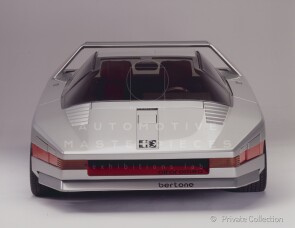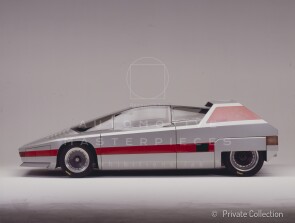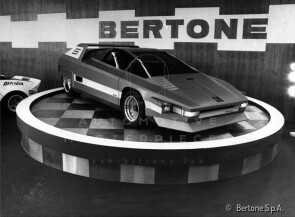
1976 Alfa Romeo 33 Navajo
ON/OFF
Why am I an Automotive Masterpiece?
In 1967 a road version of the "Tipo 33" was launched, the Alfa Romeo 33 Stradale, designed by Carlo Chiti's Autodelta and built by Carrozzeria Marazzi based on a design by Franco Scaglione in just eighteen units. This car inherited the 1,995 cm³ V8 engine from racing cars, albeit weakened to 245 hp at 8,800 rpm to improve delivery, and the H-frame, albeit lengthened to improve comfort. Of the 18 chassis made, it seems that only 12 were actually finished and only 11 sold to customers while on the basis of the last 6 the best Italian coachbuilders created a series of concept cars, in particular Pininfarina built the Roadster in 1968, in 1969 the Coupé Prototipo Speciale, designed by Leonardo Fioravanti, and in 1971 the Cuneo, by Paolo Martin; Bertone built Carabo in 1968 and Navajo in 1976, both by Marcello Gandini, while Italdesign by Giorgetto Giugiaro created the Iguana in 1969. All concept cars bear the Alfa Romeo brand and name and are now on display at the Alfa Romeo Historical Museum.
The Alfa Romeo 33 Bertone Navajo, also known as Alfa Romeo 33 Navajo or Bertone Navajo, is a dream car created by the Bertone bodyshop in 1976. The Navajo, presented at the Geneva Motor Show in March 1976, was the last dream car built on the basis of the Alfa Romeo 33 Stradale and owes its name to the Navajo tribe of Native Americans. The chassis of the Alfa Romeo 33 Stradale was lengthened in the center up to 2430 mm in order to mount a light fiberglass body (the car weighs only 870 kg) with a strongly "wedge" profile typical of the 1970s. The very tapered front is balanced by the massive tail surmounted by a huge trapezoidal rear wing which could vary its incidence according to the speed. The aerodynamics are also very accurate in the rest of the car given that the front spoiler, like the rear one, could have modified the incidence according to the speed, a feature taken up almost ten years later by Bertone on the Alfa 90. The retractable front lights had an almost unique configuration: in fact, they did not rise from the bonnet but appeared laterally from the fenders. On the front bonnet there are gills for the venting of hot air from the radiator and a sticker with the stylized Alfa Romeo logo. The side is crossed by an orange longitudinal rib in contrast with the silver paint of the rest of the bodywork which ends with the air intake to cool the brakes. Inside, in addition to the two seats made of fiberglass, there was an unusual tubular dashboard equipped with a digital instrument panel and levers instead of the classic buttons to operate the on-board controls. The car is propelled by the mechanics of the 33 Stradale, therefore by a centrally located longitudinal V8 engine with two overhead camshafts per bank of 1995 cc of displacement with SPICA mechanical injection, capable of 233 hp at 8800 rpm coupled to a 6-speed manual gearbox. After having participated in the various exhibitions, the car became part of the collection of the Museo Storico Alfa Romeo where it is still located together with the other prototypes based on the 33 Stradale.




